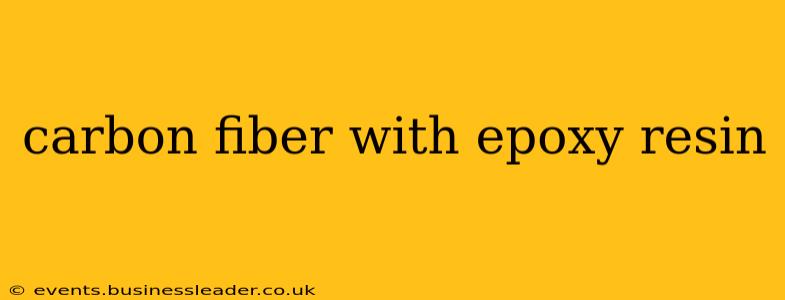Carbon fiber reinforced polymer (CFRP), more commonly known as carbon fiber, is a remarkable material celebrated for its exceptional strength-to-weight ratio. When combined with epoxy resin, it forms a composite material with a wide array of applications, from high-performance sports equipment to aerospace components. This guide delves into the intricacies of this powerful combination, exploring its properties, manufacturing processes, and diverse applications.
What is Carbon Fiber?
Carbon fiber is a material composed of extremely thin filaments of carbon atoms bonded together. These fibers are incredibly strong and stiff, far exceeding the strength of steel, yet significantly lighter. Their high tensile strength, coupled with excellent fatigue resistance, makes them ideal for applications demanding both lightness and durability.
The Role of Epoxy Resin
Epoxy resin acts as the matrix material in CFRP composites, binding the carbon fibers together and transferring loads between them. Its crucial role is to:
- Bind the fibers: Epoxy resin effectively holds the carbon fibers in place, preventing slippage and maintaining the structural integrity of the composite.
- Protect the fibers: It shields the carbon fibers from environmental factors like moisture and UV radiation, extending the lifespan of the composite.
- Transfer stress: The epoxy resin distributes the applied load evenly across the carbon fibers, allowing the composite to withstand significant stress.
- Improve impact resistance: While carbon fiber offers high tensile strength, epoxy resin enhances the composite’s ability to withstand impact.
How are Carbon Fiber and Epoxy Resin Combined?
The process of combining carbon fiber and epoxy resin involves several steps, typically including:
- Prepreg: This involves pre-impregnating the carbon fiber with epoxy resin. The resulting material, known as prepreg, is then ready for layup.
- Layup: Layers of prepreg are carefully arranged according to a specific design to achieve the desired strength and stiffness properties. The layup process requires precision to optimize the composite’s performance.
- Curing: The layered prepreg is placed in a mold and cured under controlled temperature and pressure. This process allows the epoxy resin to fully cure, forming a strong bond between the carbon fibers. Different curing methods exist, impacting the final properties of the composite.
- Post-curing: In some cases, a post-curing process may be employed to further enhance the composite’s properties and ensure optimal performance.
What are the Properties of Carbon Fiber with Epoxy Resin?
The combination of carbon fiber and epoxy resin results in a composite material with exceptional properties:
- High strength-to-weight ratio: This is arguably the most significant advantage, making CFRP composites ideal for lightweight applications.
- High stiffness: CFRP composites resist deformation under load, making them suitable for applications requiring dimensional stability.
- Fatigue resistance: They can withstand repeated cycles of loading and unloading without significant degradation.
- Chemical resistance: Epoxy resin provides good chemical resistance, protecting the carbon fibers from environmental degradation.
- Design flexibility: CFRP composites can be molded into complex shapes, allowing for intricate designs and customized parts.
What are the Applications of Carbon Fiber with Epoxy Resin?
The unique properties of carbon fiber with epoxy resin make it suitable for a wide range of applications, including:
- Aerospace: Aircraft components, spacecraft structures
- Automotive: High-performance car parts, body panels
- Sports equipment: Bicycle frames, golf clubs, tennis rackets
- Marine: Boat hulls, masts
- Industrial applications: Pressure vessels, wind turbine blades
What are the Advantages of Using Carbon Fiber with Epoxy Resin?
The advantages are numerous and stem directly from the material's properties:
- Lightweight design: Reduced weight leads to improved fuel efficiency (in vehicles and aircraft), increased speed, and enhanced maneuverability.
- High strength: Enables the creation of stronger, yet lighter structures.
- Design flexibility: Allows for complex shapes and customized designs.
- Durability: Offers long-lasting performance due to high fatigue and chemical resistance.
What are the Disadvantages of Using Carbon Fiber with Epoxy Resin?
Despite its advantages, CFRP composites also have some limitations:
- Cost: Carbon fiber and the manufacturing process can be expensive.
- Manufacturing complexity: The layup and curing processes require specialized equipment and skilled labor.
- Sensitivity to damage: While strong, CFRP composites can be susceptible to damage from impacts, especially at the edges.
- Difficult repair: Repairing damaged CFRP composites can be challenging and often requires specialized techniques.
How does the curing process affect the final properties of the composite?
The curing process significantly impacts the final properties of the CFRP composite. Different curing temperatures, pressures, and times can influence the degree of polymerization of the epoxy resin, ultimately affecting the composite's strength, stiffness, and other mechanical properties. Improper curing can lead to voids, weak bonds, and reduced performance.
What are the different types of epoxy resins used with carbon fiber?
Various types of epoxy resins are used with carbon fiber, each offering slightly different properties. The choice of resin depends on the specific application and desired performance characteristics. Some factors to consider include viscosity, curing time, temperature resistance, and chemical resistance.
How is the strength of a carbon fiber epoxy composite determined?
The strength of a carbon fiber epoxy composite is determined by several factors, including the type and orientation of the carbon fibers, the type and amount of epoxy resin, the manufacturing process, and the curing conditions. Testing methods such as tensile testing, flexural testing, and impact testing are employed to determine the composite's mechanical properties.
This comprehensive guide provides a detailed overview of carbon fiber with epoxy resin, addressing key aspects from its properties to its various applications. Remember, while this material offers exceptional advantages, it's essential to consider its limitations and select appropriate applications based on your specific needs and requirements.
